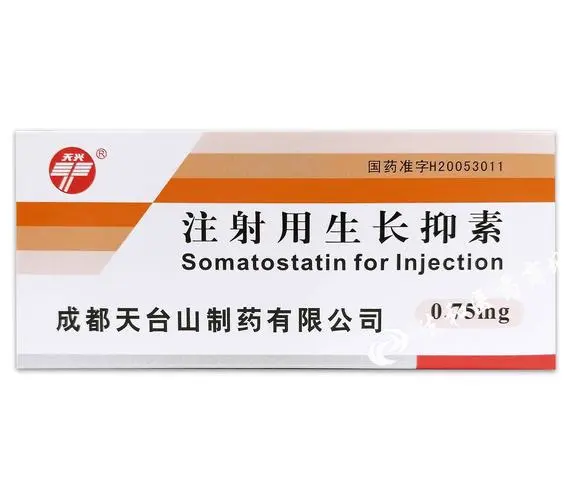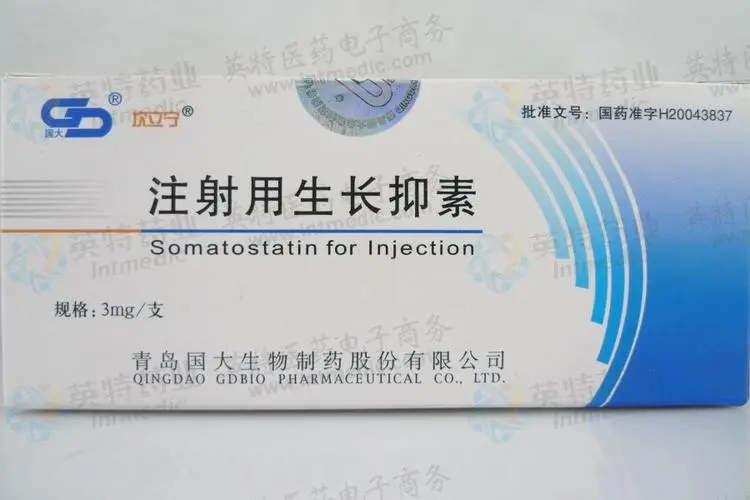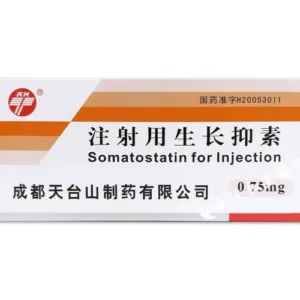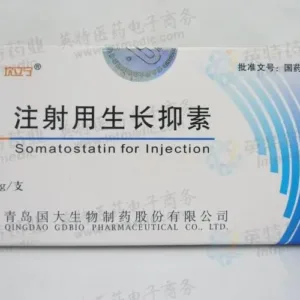SOMATOSTATIN injection
Effects and efficacy:
Somatostatin can be used for severe acute esophageal varicose bleeding. It is used for severe acute gastric or duodenal ulcer bleeding, or complicated by acute erosive gastritis or hemorrhagic gastritis. It can be used for the prevention and treatment of complications after pancreatic surgery. It can also be used as an adjuvant treatment for pancreatic, biliary and intestinal fistulas, and for the adjuvant treatment of diabetic ketoacidosis.
Usage and dosage:
For the treatment of severe acute upper gastrointestinal bleeding including esophageal varicose bleeding, first slowly inject 0.25 mg intravenously as a loading dose, and then immediately continue intravenous drip at a rate of 0.25 mg/h. When the interval between two infusions is greater than 3-5 minutes, 0.25 mg should be injected intravenously again to ensure the continuity of administration. When the bleeding stops (usually within 12-24), continue to use the drug for 48-72 hours to prevent bleeding again. The usual treatment time is 120 hours. The auxiliary treatment of pancreatic fistula, bile fistula, and intestinal fistula should be administered by continuous intravenous drip at a rate of 250 micrograms per hour until the fistula is closed (2-20 days). This treatment can be used as an auxiliary measure for total parenteral nutrition. When the fistula is closed, the intravenous drip of this product should continue for 1-3 days, and then gradually stop the drug to prevent rebound effect. Prevention and treatment of complications after pancreatic surgery At the beginning of surgery, as an auxiliary treatment, this product is dripped at a rate of 250 micrograms per hour; after surgery, the drip is continued for 5 days. Adjuvant treatment of diabetic ketoacidosis For patients with ketoacidosis, this product is dripped intravenously at a rate of 100-500 micrograms per hour and combined with insulin treatment. Ketoacidosis can be relieved within 3 hours and blood sugar can return to normal within 4 hours.
Adverse reactions:
A few cases experience nausea, dizziness, and facial flushing after taking the drug. When the drip rate of this product is higher than 50 micrograms per minute, the patient will experience nausea and vomiting. Because this product inhibits the secretion of insulin and glucagon, it may cause a temporary drop in blood sugar levels in the early stage of treatment. There are individual reports of life-threatening water retention with hyponatremia. Rebound oversecretion of growth hormone and other hormones often occurs after discontinuation of this product. Post-marketing experience: The following adverse reactions/events have been monitored for somatostatin injection (these adverse reactions/events are from spontaneous reports with uncertain sample sizes, and it is difficult to accurately estimate their frequency). Gastrointestinal system damage: nausea, vomiting, diarrhea, abdominal pain, abdominal distension, abdominal discomfort, retching. Skin and its appendage damage: rash, itching, sweating, hyperhidrosis. Cardiovascular system damage: palpitations, flushing, bradycardia, increased blood pressure. Nervous system damage: dizziness, vertigo, headache. Respiratory system damage: chest tightness, dyspnea, shortness of breath. Metabolic and nutritional disorders: hypoglycemic reaction, hypoglycemia, decreased blood sugar, increased blood sugar, hyperglycemia, hypoglycemia coma. Systemic damage: chills, fever, fatigue, high fever. Immune diseases and infections: allergic reactions, allergic reactions, anaphylactic shock. Damage to the medication site: local numbness, phlebitis, injection site pain.
Contraindications:
Contraindicated if allergic to this product; contraindicated during pregnancy; contraindicated during lactation
Share:
Products
Our offers
Health Classification
Let us work together to protect precious health






























